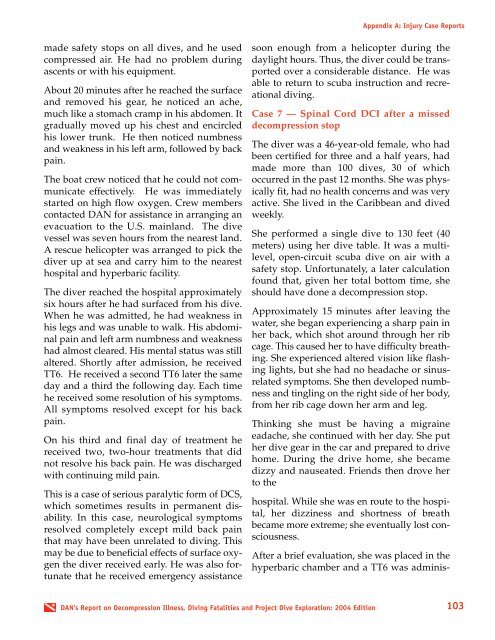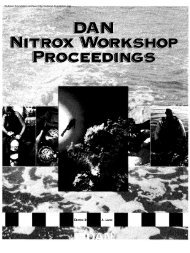Report on Decompression Illness, Diving Fatalities and Project Dive
Report on Decompression Illness, Diving Fatalities and Project Dive
Report on Decompression Illness, Diving Fatalities and Project Dive
- No tags were found...
You also want an ePaper? Increase the reach of your titles
YUMPU automatically turns print PDFs into web optimized ePapers that Google loves.
Appendix A: Injury Case <str<strong>on</strong>g>Report</str<strong>on</strong>g>smade safety stops <strong>on</strong> all dives, <strong>and</strong> he usedcompressed air. He had no problem duringascents or with his equipment.About 20 minutes after he reached the surface<strong>and</strong> removed his gear, he noticed an ache,much like a stomach cramp in his abdomen. Itgradually moved up his chest <strong>and</strong> encircledhis lower trunk. He then noticed numbness<strong>and</strong> weakness in his left arm, followed by backpain.The boat crew noticed that he could not communicateeffectively. He was immediatelystarted <strong>on</strong> high flow oxygen. Crew membersc<strong>on</strong>tacted DAN for assistance in arranging anevacuati<strong>on</strong> to the U.S. mainl<strong>and</strong>. The divevessel was seven hours from the nearest l<strong>and</strong>.A rescue helicopter was arranged to pick thediver up at sea <strong>and</strong> carry him to the nearesthospital <strong>and</strong> hyperbaric facility.The diver reached the hospital approximatelysix hours after he had surfaced from his dive.When he was admitted, he had weakness inhis legs <strong>and</strong> was unable to walk. His abdominalpain <strong>and</strong> left arm numbness <strong>and</strong> weaknesshad almost cleared. His mental status was stillaltered. Shortly after admissi<strong>on</strong>, he receivedTT6. He received a sec<strong>on</strong>d TT6 later the sameday <strong>and</strong> a third the following day. Each timehe received some resoluti<strong>on</strong> of his symptoms.All symptoms resolved except for his backpain.On his third <strong>and</strong> final day of treatment hereceived two, two-hour treatments that didnot resolve his back pain. He was dischargedwith c<strong>on</strong>tinuing mild pain.This is a case of serious paralytic form of DCS,which sometimes results in permanent disability.In this case, neurological symptomsresolved completely except mild back painthat may have been unrelated to diving. Thismay be due to beneficial effects of surface oxygenthe diver received early. He was also fortunatethat he received emergency assistanceso<strong>on</strong> enough from a helicopter during thedaylight hours. Thus, the diver could be transportedover a c<strong>on</strong>siderable distance. He wasable to return to scuba instructi<strong>on</strong> <strong>and</strong> recreati<strong>on</strong>aldiving.Case 7 — Spinal Cord DCI after a misseddecompressi<strong>on</strong> stopThe diver was a 46-year-old female, who hadbeen certified for three <strong>and</strong> a half years, hadmade more than 100 dives, 30 of whichoccurred in the past 12 m<strong>on</strong>ths. She was physicallyfit, had no health c<strong>on</strong>cerns <strong>and</strong> was veryactive. She lived in the Caribbean <strong>and</strong> divedweekly.She performed a single dive to 130 feet (40meters) using her dive table. It was a multilevel,open-circuit scuba dive <strong>on</strong> air with asafety stop. Unfortunately, a later calculati<strong>on</strong>found that, given her total bottom time, sheshould have d<strong>on</strong>e a decompressi<strong>on</strong> stop.Approximately 15 minutes after leaving thewater, she began experiencing a sharp pain inher back, which shot around through her ribcage. This caused her to have difficulty breathing.She experienced altered visi<strong>on</strong> like flashinglights, but she had no headache or sinusrelatedsymptoms. She then developed numbness<strong>and</strong> tingling <strong>on</strong> the right side of her body,from her rib cage down her arm <strong>and</strong> leg.Thinking she must be having a migraineeadache, she c<strong>on</strong>tinued with her day. She puther dive gear in the car <strong>and</strong> prepared to drivehome. During the drive home, she becamedizzy <strong>and</strong> nauseated. Friends then drove herto thehospital. While she was en route to the hospital,her dizziness <strong>and</strong> shortness of bre a t hbecame more extreme; she eventually lost c<strong>on</strong>sciousness.After a brief evaluati<strong>on</strong>, she was placed in thehyperbaric chamber <strong>and</strong> a TT6 was adminis-DAN’s <str<strong>on</strong>g>Report</str<strong>on</strong>g> <strong>on</strong> Decompressi<strong>on</strong> <strong>Illness</strong>, <strong>Diving</strong> <strong>Fatalities</strong> <strong>and</strong> <strong>Project</strong> <strong>Dive</strong> Explorati<strong>on</strong>: 2004 Editi<strong>on</strong> 103
















